| Sign language is a three dimensional, visual language that uses the hands, arms, shoulders, head, face, lips and tongue of the signer as 'articulators'. In filming signing books the camera therefore doesn't only record people, objects, scenery; and actions, the camera also records the text: the sign language. For viewers to understand what is being signed, the camera must record the sign language naturally and completely. Cut-offs (hands moving outside the range of the camera), obstructions (scenery or people blocking the view of a signer), close-ups and long-distance shots should all be avoided. Different lenses, movements of the camera, variations in shots may be used to add visual interest, but should be functional and should not be allowed to interfere with the visibility of the signer and the sign language. |
During the filming, the camera-person will have to find a balance between good visibility of the signer(s), and varied and interesting use of available camera-techniques: shots, angles, viewpoint, movement and lenses.
The camera set-up will at least include the 'signing space' of the signer(s), either with or without some background scenery. How large the signing space of a signer is, will depend on the signer, and on the register that is used for (a part of) a story. On average, the signing space is a triangle with the top located slightly above the head of the signer, and the base at waist line (see examples below).
If the signer is to be superimposed on a video, by means of a sign language 'bubble' or 'box' (see chapter 13) a smaller signing space is usually used, and the signer is filmed from the chest up.
The signer's body location and body movements have a syntactic function in sign language. The camera should record these naturally with continuity in sight lines within and between successive shots.
Although facial expression is very important in sign language, close-ups are almost never used because of the risk that the hands will move outside of the view of the camera. Close-ups are only possible during 'silent' periods, and must be carefully choreographed.
When two signers are filmed together, they can either address each other, or the camera. When the two signers address each other, the distance between the two signers must be natural (at least 1 meter). If one camera is used, both signers can be filmed in one shot, or the camera can zoom in on the signing person. Again, this has to be carefully choreographed, to avoid the camera ping-ponging from one signer to the other, or parts of a conversation being invisible because the camera was focused on the wrong person. With two or more cameras, there is of course more flexibility.
Long distance shots are generally not used either, because the signs and/or the face of the signer will be too far off for good visibility. Generally speaking, the signer should be as close to the camera as is possible without risking cut-offs, to suggest real interaction and eye-contact with the viewer. For recordings of discussions or group conversations, it is not feasible to have more than 3 signers in one shot. More signers would have to sit too close together to be comfortable, or the distance to the camera would be too far for viewers to properly see the sign language, and/or to watch as participants in the dialogue or discussion, instead of as distant by-standers.
A signer can be filmed from the side, but not from the back. Generally speaking, frontal or semi-profile shots are preferred because these result in the best visibility of the hands, face, and body movements of the signer. The same applies to the angle of the camera: high and low angles can be used, but only if this is functional. Generally speaking, the camera should be at eye-level with the signer.
When a single signer is presenting a story, the signer is usually filmed from the knees or waist up, in a fixed position, standing up. Unless there is a visible audience (e.g. children watching the story) the signer addresses the camera directly. Variations are: a signer sitting in a chair, the signer on location with some variations in background, the signer addressing and interacting with a visible audience.
Camera movements within and between shots should be functional, and should not interfere with the visibility of the sign language.
A camera can zoom in on scenery or props - but unless these shots are combined with shots of the signer during editing, this will result in 'silent' periods in the end-product.
When a signer is to be superimposed on visuals, the signer is usually filmed standing up, in a fixed position and a fixed shot: from the knees or the waist up (medium full shot to medium close shot). If visuals are to be shown simultaneously with the signer, appropriate space should be reserved where visuals can be added during the editing.
The signer always addresses the camera - but may turn towards the picture (to the left or to the right, depending on where the visuals will be superimposed) either to indicate a silent period, or to refer to the visuals. The signers use of space and localisation should correspond to the visuals.
If captions or subtitles are to be superimposed over the signer (see chapter 17) some extra space should be reserved to allow for this.
To add visual interest and action, a signer can walk around a stage or location, or two signers can be shown, interacting. To minimise the risk of cut-offs, and signers or (parts of) signs going out of the range of the camera, these movements should be carefully choreographed.
If the movements, and the signing, of the signer(s) are choreographed and known to the cameraperson, s/he can be more creative in the use of viewpoints, distances and angles as well.
 |
 |
 |
 |
| Hans im Glück, Signum, DE | Baby’s first book, Chase Video, GB | De man, de stad en het boek. | Handtheater, NL |
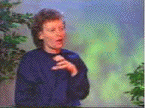 |
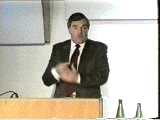 |
 |
| Hans och Greta, SIH, SE | Signing Books prototype, City University | Sprookjes voor dove kinderen 1, FODOK NL |
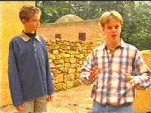 |
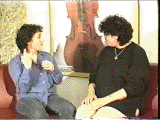 |
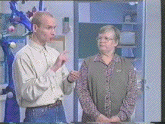 |
| Naar Jezus, Dit Koningskind, NL | Signing Books prototype, City University London | Kuurojen Video, FI |
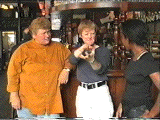 |
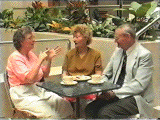 |
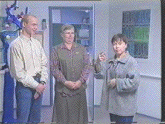 |
| Signing Books prototype, City University London | Signing Books prototype, City University London | Kuurojen Video, FI |
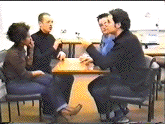 |
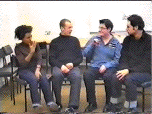 |
|
| Signing Books prototypes, | City University London |